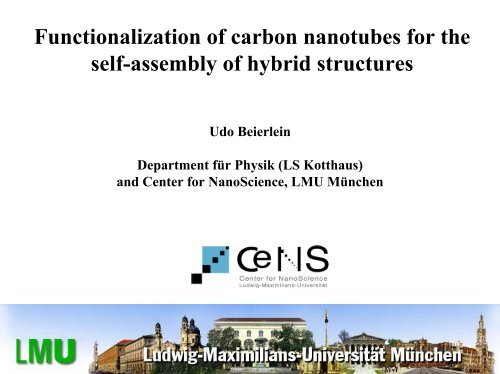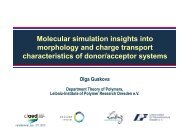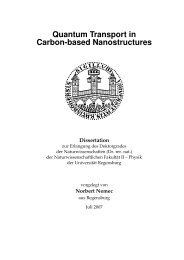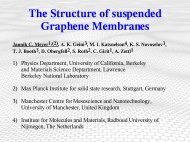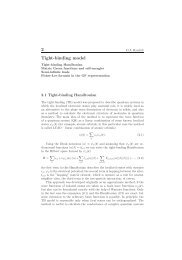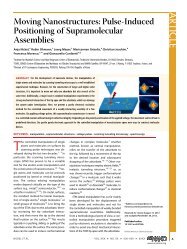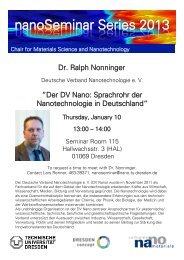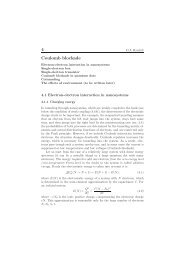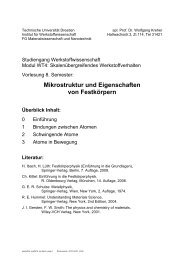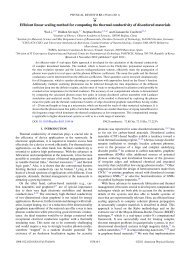Functionalization of carbon nanotubes for the self-assembly of ...
Functionalization of carbon nanotubes for the self-assembly of ...
Functionalization of carbon nanotubes for the self-assembly of ...
Create successful ePaper yourself
Turn your PDF publications into a flip-book with our unique Google optimized e-Paper software.
<strong>Functionalization</strong> <strong>of</strong> <strong>carbon</strong> <strong>nanotubes</strong> <strong>for</strong> <strong>the</strong><br />
<strong>self</strong>-<strong>assembly</strong> <strong>of</strong> hybrid structures<br />
Udo Beierlein<br />
Department für Physik (LS Kotthaus)<br />
and Center <strong>for</strong> NanoScience, LMU München
Carbon Nanotubes<br />
Molecular electronics group activities:<br />
Pentacene TFTs<br />
Polyphenylene SAMs<br />
(= <strong>self</strong>-assembled<br />
monolayers)
Outline<br />
Non-covalent functionalization <strong>of</strong> CNTs<br />
Covalent functionalization <strong>of</strong> CNTs<br />
- chemical procedure<br />
- attaching gold particles to CNTs by <strong>self</strong>-<strong>assembly</strong><br />
- electronic transport measurements<br />
- catalytic gold enhancement<br />
- thiolation <strong>of</strong> CNTs<br />
Summary & Outlook
Motivation
- Non-specific functionalization<br />
<strong>of</strong> <strong>carbon</strong> <strong>nanotubes</strong> with SDS:<br />
- <strong>Functionalization</strong> <strong>of</strong><br />
gold electrodes with<br />
cysteamine:<br />
Non-covalent functionalization <strong>of</strong> CNTs<br />
= ><br />
5 <br />
<br />
0 !<br />
+ 0 "<br />
5<br />
<br />
+ 0<br />
"<br />
#<br />
+ 6<br />
5 <br />
<br />
0 !<br />
+ 0 "<br />
5<br />
<br />
+ 0<br />
"<br />
#<br />
) K<br />
SiO 2<br />
5 <br />
<br />
0 !<br />
+ 0 "<br />
5<br />
<br />
+ 0<br />
"<br />
AFM image <strong>of</strong> MWNTs bridging Au electrodes (scalebar: 1 µm)<br />
#
Fluorescence labeling <strong>of</strong> MWNTs<br />
DiOC 6
Covalent functionalization: chemical procedure<br />
1. step: acid treatment => carboxyl end-groups<br />
• <strong>nanotubes</strong> are usually endcapped<br />
• length up to several microns<br />
Ultrasonification in H 2SO 4/ H 2O 2 or in H 2SO 4/ HNO 3<br />
+ filtration<br />
• <strong>nanotubes</strong> with open ends<br />
• shortened in length<br />
• „clean“ solution
Carboxyl end-groups as a starting point <strong>for</strong> chemical<br />
modifications<br />
: COO -<br />
: COOH<br />
2. step: Conversion <strong>of</strong> <strong>the</strong> carboxyl groups to <strong>the</strong> corresponding acid chloride by<br />
refluxing in thionyl chloride<br />
R-COOH + SOCl 2 → R-COCl + SO 2 + HCl<br />
The chlorine group is very reactive and allows versatile modification
Test experiment: Attachment <strong>of</strong> molecular linkers<br />
• Allows end-to-side as well as<br />
end-to-end interconnections<br />
• linker: alkane chain
3. step: Biotinylation<br />
• Biotin is a vitamine that binds specifically to<br />
its corresponding protein streptavidin<br />
• The biotin-streptavidin interaction is <strong>the</strong> strongest<br />
non-covalent binding in nature<br />
• Up to four biotin molecules can bind to<br />
one streptadvidin
• replace chloride by<br />
ethylenediamine<br />
• attach NHS-biotin<br />
Biotinylation<br />
4. step: react with streptavidin-modified gold particles
5. step: making contacts<br />
• apply CNT-nanoparticle<br />
solution on a Si chip<br />
• locate interesting structures<br />
with AFM<br />
• make contacts using optical and<br />
e-beam lithography<br />
optically<br />
defined<br />
supply lines<br />
e-beam<br />
defined<br />
raster<br />
deposition <strong>of</strong><br />
droplet<br />
with<br />
functionalized<br />
tubes on <strong>the</strong> chip<br />
location <strong>of</strong><br />
deposited<br />
tubes by AFM<br />
1 µm<br />
contacting <strong>of</strong> individual<br />
<strong>nanotubes</strong>
Electronic transport measurements<br />
Non-linear source-drain curve at<br />
T = 300 K and at T = 4.2 K:<br />
At least one <strong>of</strong> <strong>the</strong> two SWNTs<br />
is semiconducting<br />
Linear source-drain curve at<br />
T = 300 K and non-linear at T = 4.2 K:<br />
two metallic SWNTs<br />
Coulomb blockade at low T
E C<br />
2<br />
e<br />
=<br />
C<br />
Coulomb blockade<br />
C<br />
2πε rε<br />
0L<br />
= CColloid =<br />
4πε rε<br />
0r<br />
ln(<br />
2z<br />
/ r)<br />
Charging energies:<br />
E C,small ~ 93 meV C small ~ 1.7 aF L CNT,small ~ 94 nm r colloid,small ~ 7.7 nm<br />
E C,big ~ 135 meV C big ~ 1.2 aF L CNT,big ~ 65 nm r colloid,big ~ 5.3 nm<br />
CNT
The contacted colloids with d = 25 nm have<br />
been enlarged by catalytic gold enhancement<br />
Catalytic gold enhancement<br />
Au-ions are refined at <strong>the</strong><br />
seed metal in <strong>the</strong> presence<br />
<strong>of</strong> a reducing agent<br />
Two AFM-pictures <strong>of</strong> a colloid with d = 25 nm, be<strong>for</strong>e and<br />
after 2 minutes incubation with Nanoprobe Goldenhance<br />
Factors, <strong>the</strong> resistance was<br />
decreasing at V = -0.75 V:<br />
5 Samples<br />
2 Samples<br />
1 Sample<br />
factor<br />
2 - 9<br />
0<br />
short circuit
Self-<strong>assembly</strong> <strong>of</strong> CNTs on contacts?<br />
Thiolation <strong>of</strong> CNTs<br />
R =
CNT alignment by surface acoustic waves<br />
in collaboration with C. Strobl, J. Ebbecke, A. Wix<strong>for</strong>th, Uni Augsburg<br />
C. Strobl, C. Schäflein, U. Beierlein, J. Ebbecke, A. Wix<strong>for</strong>th, APL 85, 1427, 2004
Thiolated CNTs on gold contacts
Summary<br />
• CNTs can be chemically modified in order to achieve some degree <strong>of</strong><br />
molecular recognition and <strong>self</strong>-<strong>assembly</strong><br />
• SWNTs were connected via gold colloids<br />
• These systems were individually electrically contacted and<br />
characterized in <strong>the</strong>ir electronic properties<br />
• SWNTs were attached to electrodes via thiol-groups using SAW
Christian J.-F. Dupraz<br />
Pr<strong>of</strong>. Jörg P. Kotthaus<br />
Thanks<br />
Tobias Smorodin Carla Abilio<br />
Nok Tsao Matthias Fiebig


